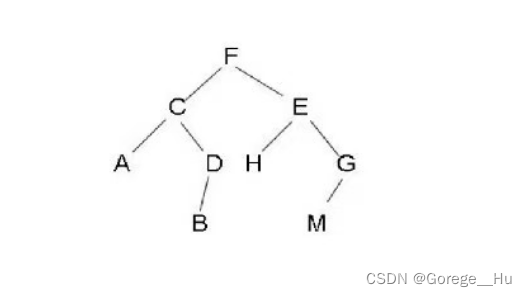一、实验目的及要求
1.掌握二叉树的定义及其链式存储结构。
2.掌握二叉树的先序遍历、中序遍历和后序遍历,并将结果序列输出
二、实验内容
1.先序创建二叉树。
2.定义队列,进行入队,出队操作。
3.树的层次、先序、中序和后序遍历
4.并输出叶子结点个数以及二叉树的高度
三、实验步骤和要求
以下图所示的二叉树为例编制程序,实现实验内容中所述功能。

二叉树定义:
//定义二叉树节点结构体
typedef struct node
{
char stu;
struct node *lchild, *rchild;
} Node;
//定义队列结构体
typedef struct
{
Node data[MAX];
int head, rear;
} SqQueue;
创建新节点:
//创建新节点
Node *createNode(char stu)
{
// 1.创建节点
Node *node = (Node *)malloc(sizeof(Node));
// 2.判断是否拿到内存
if (!node)
exit(-1);
// 3.将输入的参数赋值给新拿到的内存空间
node->stu = stu;
node->lchild = node->rchild = NULL;
// 4.将输入的参数赋值给新拿到的内存空间
// 5.返回创建好的节点
return node;
}
初始化一个二叉树:
//初始化一个二叉树
Node *createTree(Node *tree)
{
// 1.设置一个标记,告诉程序是否继续添加节点
int tag = 0;
printf("是否有左子树或者右子树,如果有,输入1,否则输入0:");
scanf("%d", &tag);
getchar();
// 2.如果继续添加节点,需要给节点初始化
if (tag != 0)
{
char stu;
printf("请输入节点值:");
scanf("%s", &stu);
tree = createNode(stu);
// 3.继续添加左子树,继续添加右子树
tree->lchild = createTree(tree->lchild);
tree->rchild = createTree(tree->rchild);
}
// 4.要返回创建的子树
return tree;
}
销毁二叉树;
//销毁二叉树
void destroyTree(Node *tree)
{
if (tree != NULL)
{
destroyTree(tree->lchild);
destroyTree(tree->rchild);
free(tree);
}
}
先序遍历二叉树:
//先序遍历二叉树
void preOrderTree(Node *tree)
{
if (tree != NULL)
{
printf("%s \n", tree->stu);
preOrderTree(tree->lchild);
preOrderTree(tree->rchild);
}
}
中序遍历二叉树:
//中序遍历二叉树
void inOrderTree(Node *tree)
{
if (tree != NULL)
{
inOrderTree(tree->lchild);
printf("%s \n", tree->stu);
inOrderTree(tree->rchild);
}
}
后序遍历二叉树:
//后序遍历二叉树
void postOrderTree(Node *tree)
{
if (tree != NULL)
{
postOrderTree(tree->lchild);
postOrderTree(tree->rchild);
printf("%s \n", tree->stu);
}
}
统计二叉树中的节点个数;
//统计二叉树中的节点个数
void numNode(Node *tree, int *num)
{
if (tree != NULL)
{
numNode(tree->lchild, num);
numNode(tree->rchild, num);
(*num)++;
}
}
层次遍历二叉树:
//层次遍历二叉树
// 1.初始化队列
//判断队是否为空
//队不为空则返回1,队空则返回0
int EmptyQueue(SqQueue *Q)
{
if (Q->head == Q->rear)
{
return 0;
}
else
{
return 1;
}
}
//2.入队
void PushQueue(SqQueue *Q, Node t)
{
Q->rear = (Q->rear + 1) % MAX;
Q->data[Q->rear] = t;
}
//3.出队
void PopQueue(SqQueue *Q)
{
Q->head = (Q->head + 1) % MAX;
}
//层次遍历二叉树
void Leavel_Order(Node *tree)
{
SqQueue Q;
//定义一个循环队列
Q.head = 0;
Q.rear = 0;
//循环队列初始化
//队为空的条件:队头等于队尾
Node *temp;
//定义一个二叉树类型的指针
PushQueue(&Q, *tree);
//根节点入队
while (EmptyQueue(&Q))
//当队不为空时,循环
{
*temp = Q.data[Q.head + 1];
//将队头元素赋值给变量*temp
printf("%s \n", temp->stu);
//输出队头元素的值
PopQueue(&Q);
//队头元素出队
if (temp->lchild != NULL)
//如果左孩子不为空,则左子树入队
{
PushQueue(&Q, *temp->lchild);
}
//如果右孩子不为空,则右子树入队
if (temp->rchild != NULL)
{
PushQueue(&Q, *temp->rchild);
}
}
}
计算树的高度:
int tree_height(Node *root)
{
// Get the height of the tree
if (!root)
return 0;
else
{
// Find the height of both subtrees
// and use the larger one
int left_height = tree_height(root->lchild);
int right_height = tree_height(root->rchild);
if (left_height >= right_height)
return left_height + 1;
else
return right_height + 1;
}
}
全部代码:
/*二叉树*/
#include <stdio.h>
#include <stdlib.h>
#define MAX 40
//定义二叉树节点结构体
typedef struct node
{
char stu;
struct node *lchild, *rchild;
} Node;
//定义队列结构体
typedef struct
{
Node data[MAX];
int head, rear;
} SqQueue;
//创建新节点
Node *createNode(char stu)
{
// 1.创建节点
Node *node = (Node *)malloc(sizeof(Node));
// 2.判断是否拿到内存
if (!node)
exit(-1);
// 3.将输入的参数赋值给新拿到的内存空间
node->stu = stu;
node->lchild = node->rchild = NULL;
// 4.将输入的参数赋值给新拿到的内存空间
// 5.返回创建好的节点
return node;
}
//初始化一个二叉树
Node *createTree(Node *tree)
{
// 1.设置一个标记,告诉程序是否继续添加节点
int tag = 0;
printf("是否有左子树或者右子树,如果有,输入1,否则输入0:");
scanf("%d", &tag);
getchar();
// 2.如果继续添加节点,需要给节点初始化
if (tag != 0)
{
char stu;
printf("请输入节点值:");
scanf("%s", &stu);
tree = createNode(stu);
// 3.继续添加左子树,继续添加右子树
tree->lchild = createTree(tree->lchild);
tree->rchild = createTree(tree->rchild);
}
// 4.要返回创建的子树
return tree;
}
//销毁二叉树
void destroyTree(Node *tree)
{
if (tree != NULL)
{
destroyTree(tree->lchild);
destroyTree(tree->rchild);
free(tree);
}
}
//先序遍历二叉树
void preOrderTree(Node *tree)
{
if (tree != NULL)
{
printf("%s \n", tree->stu);
preOrderTree(tree->lchild);
preOrderTree(tree->rchild);
}
}
//中序遍历二叉树
void inOrderTree(Node *tree)
{
if (tree != NULL)
{
inOrderTree(tree->lchild);
printf("%s \n", tree->stu);
inOrderTree(tree->rchild);
}
}
//后序遍历二叉树
void postOrderTree(Node *tree)
{
if (tree != NULL)
{
postOrderTree(tree->lchild);
postOrderTree(tree->rchild);
printf("%s \n", tree->stu);
}
}
//统计二叉树中的节点个数
void numNode(Node *tree, int *num)
{
if (tree != NULL)
{
numNode(tree->lchild, num);
numNode(tree->rchild, num);
(*num)++;
}
}
//层次遍历二叉树
// 1.初始化队列
//判断队是否为空
//队不为空则返回1,队空则返回0
int EmptyQueue(SqQueue *Q)
{
if (Q->head == Q->rear)
{
return 0;
}
else
{
return 1;
}
}
//2.入队
void PushQueue(SqQueue *Q, Node t)
{
Q->rear = (Q->rear + 1) % MAX;
Q->data[Q->rear] = t;
}
//3.出队
void PopQueue(SqQueue *Q)
{
Q->head = (Q->head + 1) % MAX;
}
//层次遍历二叉树
void Leavel_Order(Node *tree)
{
SqQueue Q;
//定义一个循环队列
Q.head = 0;
Q.rear = 0;
//循环队列初始化
//队为空的条件:队头等于队尾
Node *temp;
//定义一个二叉树类型的指针
PushQueue(&Q, *tree);
//根节点入队
while (EmptyQueue(&Q))
//当队不为空时,循环
{
*temp = Q.data[Q.head + 1];
//将队头元素赋值给变量*temp
printf("%s \n", temp->stu);
//输出队头元素的值
PopQueue(&Q);
//队头元素出队
if (temp->lchild != NULL)
//如果左孩子不为空,则左子树入队
{
PushQueue(&Q, *temp->lchild);
}
//如果右孩子不为空,则右子树入队
if (temp->rchild != NULL)
{
PushQueue(&Q, *temp->rchild);
}
}
}
int tree_height(Node *root)
{
// Get the height of the tree
if (!root)
return 0;
else
{
// Find the height of both subtrees
// and use the larger one
int left_height = tree_height(root->lchild);
int right_height = tree_height(root->rchild);
if (left_height >= right_height)
return left_height + 1;
else
return right_height + 1;
}
}
int main()
{
int num = 0, height = 0;
Node *tree = createTree(tree);
printf("先序遍历:\n");
preOrderTree(tree);
printf("中序遍历:\n");
inOrderTree(tree);
printf("后序遍历:\n");
postOrderTree(tree);
printf("层次遍历:\n");
Leavel_Order(tree);
height = tree_height(tree);
printf("树的高度是:%d\n", height);
numNode(tree, &num);
printf("节点个数是%d个\n", num);
destroyTree(tree);
system("pause");
return 0;
}























 96
96











 被折叠的 条评论
为什么被折叠?
被折叠的 条评论
为什么被折叠?










